
(a)
Find the coefficient of restitution between A and B
(a)
Answer to Problem 13.178P
The coefficient of restitution between A and B
Explanation of Solution
Given information:
The weight of the block A
The weight of the block B
The weight of the block C
The coefficient of friction between the block and plane
The initial speed of the block A
The blocks B and C are at rest.
The distance between the blocks (d) is
The width of the each blocks (b) is
The acceleration due to gravity (g) is
Calculation:
Calculate the mass of the block A
Substitute
Calculate the mass of the block B
Substitute
Calculate the mass of the block C
Substitute
Show the diagram of the block A just before its impact with block B as in Figure (1).
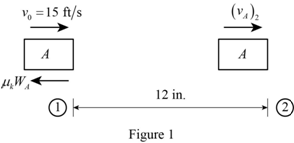
The expression for the initial kinetic energy of the block A at position ‘1’
Here,
The expression for the kinetic energy of the block A at position ‘2’ just before its impact with blocks B
Here,
The expression for the work done by the block A to overcome frictional force
The expression for the principle of work and energy to the block A at position ‘1’ and position ‘2’ just before its impact with block B as follows:
Substitute
Substitute
Show the diagram of the block A just after its impact with block B as in Figure (2).
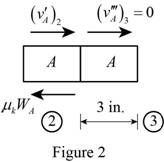
The expression for the kinetic energy of the block A immediately after the impact
Here,
The block finally comes to stop after the impact. Thus,
The expression for the work done by the block A after the collision to overcome the frictional force
The expression for the principle of work and energy to the block A after it collides with block B to find the velocity of the block A after its impact with B as follows:
Substitute
Substitute
Show the momentum impact diagram of the blocks A and B as in Figure (3).
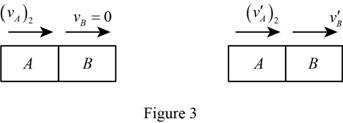
The expression for the principle of conservation of momentum to the collision between the block A and block B as follows:
Here,
Substitute
Calculate the coefficient of restitution for the impact between the block A and block B
Substitute 0 for
Therefore, the coefficient of restitution between A and B
(b)
Find the displacement (x) of block C.
(b)
Answer to Problem 13.178P
The displacement (x) of block C is
Explanation of Solution
Given information:
The weight of the block A
The weight of the block B
The weight of the block C
The coefficient of friction between the block and plane
The initial speed of the block A
The blocks B and C are at rest.
The distance between the blocks (d) is
The width of the each blocks (b) is
The acceleration due to gravity (g) is
Calculation:
Show the diagram of the block B just before its impact with block C as in Figure (4).
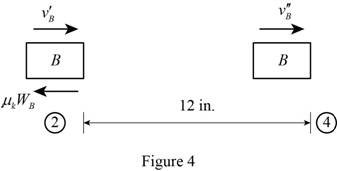
The expression for the kinetic energy of the block B at position ‘2’ just after the impact with block A
The expression for the kinetic energy of the block B just before its impact with blocks C at the position ‘4’
Here,
The expression for the work done by the block B to overcome the frictional force in reaching position ‘4’ from position ‘2’ as follows:
The expression for the principle of work and energy to the block B just before its impact with block C at the position ‘2’ and position ‘4’ as follows:
Substitute
Substitute
Show the momentum impact diagram of the blocks B and C as in Figure (5).
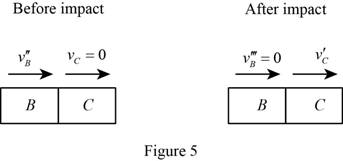
The expression for the principle of conservation of momentum to the collision between the block B and block C as follows:
Substitute
Here,
Substitute
Calculate the coefficient of restitution for the impact between the block B and block C
Substitute 0 for
Show the diagram of the block C after its impact with Block B as in Figure (6).

The expression for the kinetic energy of the block C immediately after its impact with blocks B at position ‘4’
Finally, at the position ‘5’, the block C comes to rest. Thus,
The expression for the work done by the block C to overcome the frictional force in reaching the position ‘5’
Here, x is the distance travelled by the block C before coming to rest.
The expression for the principle of work and energy to the block C after its impact with block B as follows:
Substitute
Substitute
Therefore, displacement (x) of block C is
Want to see more full solutions like this?
Chapter 13 Solutions
Vector Mechanics for Engineers: Statics and Dynamics
- Situation 01. A 4kg ball and 3kg ball move on a smooth plane along a straight path with speeds equivalent to 6m/s going to the right and 8 m/s going to the left, respectively a. Determine the speed of the 3kg ball after impact if the impact is elastic. b. Determine the speed of the 3kg ball after impact if the coefficient of restitution is 0.50. complete solution of impulse and momentumarrow_forwardThe elastic cord has an unstretched length l0 = 1.5 ft and a stiffness k = 12 lb/ft. It is attached to a fixed point at A and a block at B, which has a weight of W = 2.2 lb. The block is released from the rest from the position shown. After leaving the guide, it is launched onto the smooth horizontal plane. (Figure 1) (A) Determine its speed when it reaches point C after it slides along the smooth guide. Express your answer to three significant figures and include the appropriate units. (B) Will the angular momentum of the block about point A be conserved after it passes point C? yes or no. (C) Calculate the magnitude of the angular momentum of the block about point A, at any instant after it passes point C. Express your answer using three significant figures. (D) Determine if the cord becomes unstretched. The cord will not become unstretched The cord will become unstretchedarrow_forwardThe elastic cord has an unstretched length l0 = 1.5 ft and a stiffness k = 12 lb/ft. It is attached to a fixed point at A and a block at B, which has a weight of W = 2.2 lb. The block is released from the rest from the position shown. After leaving the guide, it is launched onto the smooth horizontal plane. (Figure 1) (A) Determine its speed when it reaches point C after it slides along the smooth guide. Express your answer to three significant figures and include the appropriate units. (B) Will the angular momentum of the block about point A be conserved after it passes point C? yes or no.arrow_forward
- A carnival ride is designed to allow the general public to experience high acceleration motion. The ride rotates about Point O in a horizontal circle such that the rider has a speed v0. The rider reclines on a platform A. The platform and the riders (80 kg total) can move up and down the inclined wall as the speed of the ride increases. The coefficient of static friction between the wall and the platform is 0.29.Determine the range of values of the constant speed v0 for which the platform will remain in the position shown.arrow_forwardBlock A, 3 kg, is initially traveling with velocity 28.6 m/s to the left on a frictionless surface as shown below. The block slides across a rough patch of ground, , and then smoothly onto a frictionless ramp. Gravity acts as shown. Determine the hight of the block A could reach climbing up the ramp (hint: at this instant, speed of the block A will be zero) : Hight = ___ m.arrow_forwardWile E. Coyote runs into a painting of a tunnel at 15 mph at a 30◦ angle as shown below. After bouncing off of the painting with a coefficient of restitution e = 0.8 he slides along the ground with a coefficient of friction of μk = 0.4. Where does he come to rest?arrow_forward
- The coefficient of kinetic friction between the60-kg crate and the ground is μk=0.3. The crate starts from rest, and P = 235 N Determine the velocity of the crate when t = 3 s Express your answer to three significant figures and include the appropriate units. Determine the distance the crate travels when 3 s Express your answer to three significant figures and include the appropriate units.arrow_forwardA 50,000 lb box car going 25 mi/h is to be hitched to a gondola carrying bulk copper ore (netweight = 100,000 lb). Determine the velocity of both the railroad cars after being hitched if thegondola is initially at rest. Determine the time it takes for both railroad cars to come to rest. μk (Gondola)= 0.30arrow_forwardA 40-lb suitcase slides from the rest 20 ft down the ramp. The suitcase has an initial velocity down the ramp of v_A = 13 ft/s and the coefficient of kinetic friction along AB is μk = 0.25. (a) How long does it take to go from A to C? Express your answer to three significant figures and include the appropriate units. (b) Determine the point where it strikes the ground at C. Express your answer to three significant figures and include the appropriate units.arrow_forward
- A 2500-lb automobile is moving at a speed of 60 mi/h when the brakes are fully applied, causing all four wheels to skid. Determine the time required to stop the automobile (a) on dry pavement (μk= 0.75), (b) on an icy road (μk= 0.10).arrow_forwardBlocks A and B weigh 25 lb and 10 lb, respectively, and they are both at a height 6 ft above the ground when the system is released from rest. Just before hitting the ground, block A is moving at a speed of 9 ft/s. Determine (a) the amount of energy dissipated in friction by the pulley, (b) the tension in each portion of the cord during the motion.arrow_forwardA locomotive exerts a constant force 200,000 lbs on a set of series-connected railroad carsweighing 5,000,000 lbs and having a total axel friction and rolling resistance of 2,000 lbs. Thetrain travels up a ramp inclined at 2° with an initial velocity of 5 ft/s from point A to point B asshown. The distance from A to B is one mile. Determine the power delivered by the locomotivewhen it has reached point B.arrow_forward
 Elements Of ElectromagneticsMechanical EngineeringISBN:9780190698614Author:Sadiku, Matthew N. O.Publisher:Oxford University Press
Elements Of ElectromagneticsMechanical EngineeringISBN:9780190698614Author:Sadiku, Matthew N. O.Publisher:Oxford University Press Mechanics of Materials (10th Edition)Mechanical EngineeringISBN:9780134319650Author:Russell C. HibbelerPublisher:PEARSON
Mechanics of Materials (10th Edition)Mechanical EngineeringISBN:9780134319650Author:Russell C. HibbelerPublisher:PEARSON Thermodynamics: An Engineering ApproachMechanical EngineeringISBN:9781259822674Author:Yunus A. Cengel Dr., Michael A. BolesPublisher:McGraw-Hill Education
Thermodynamics: An Engineering ApproachMechanical EngineeringISBN:9781259822674Author:Yunus A. Cengel Dr., Michael A. BolesPublisher:McGraw-Hill Education Control Systems EngineeringMechanical EngineeringISBN:9781118170519Author:Norman S. NisePublisher:WILEY
Control Systems EngineeringMechanical EngineeringISBN:9781118170519Author:Norman S. NisePublisher:WILEY Mechanics of Materials (MindTap Course List)Mechanical EngineeringISBN:9781337093347Author:Barry J. Goodno, James M. GerePublisher:Cengage Learning
Mechanics of Materials (MindTap Course List)Mechanical EngineeringISBN:9781337093347Author:Barry J. Goodno, James M. GerePublisher:Cengage Learning Engineering Mechanics: StaticsMechanical EngineeringISBN:9781118807330Author:James L. Meriam, L. G. Kraige, J. N. BoltonPublisher:WILEY
Engineering Mechanics: StaticsMechanical EngineeringISBN:9781118807330Author:James L. Meriam, L. G. Kraige, J. N. BoltonPublisher:WILEY





